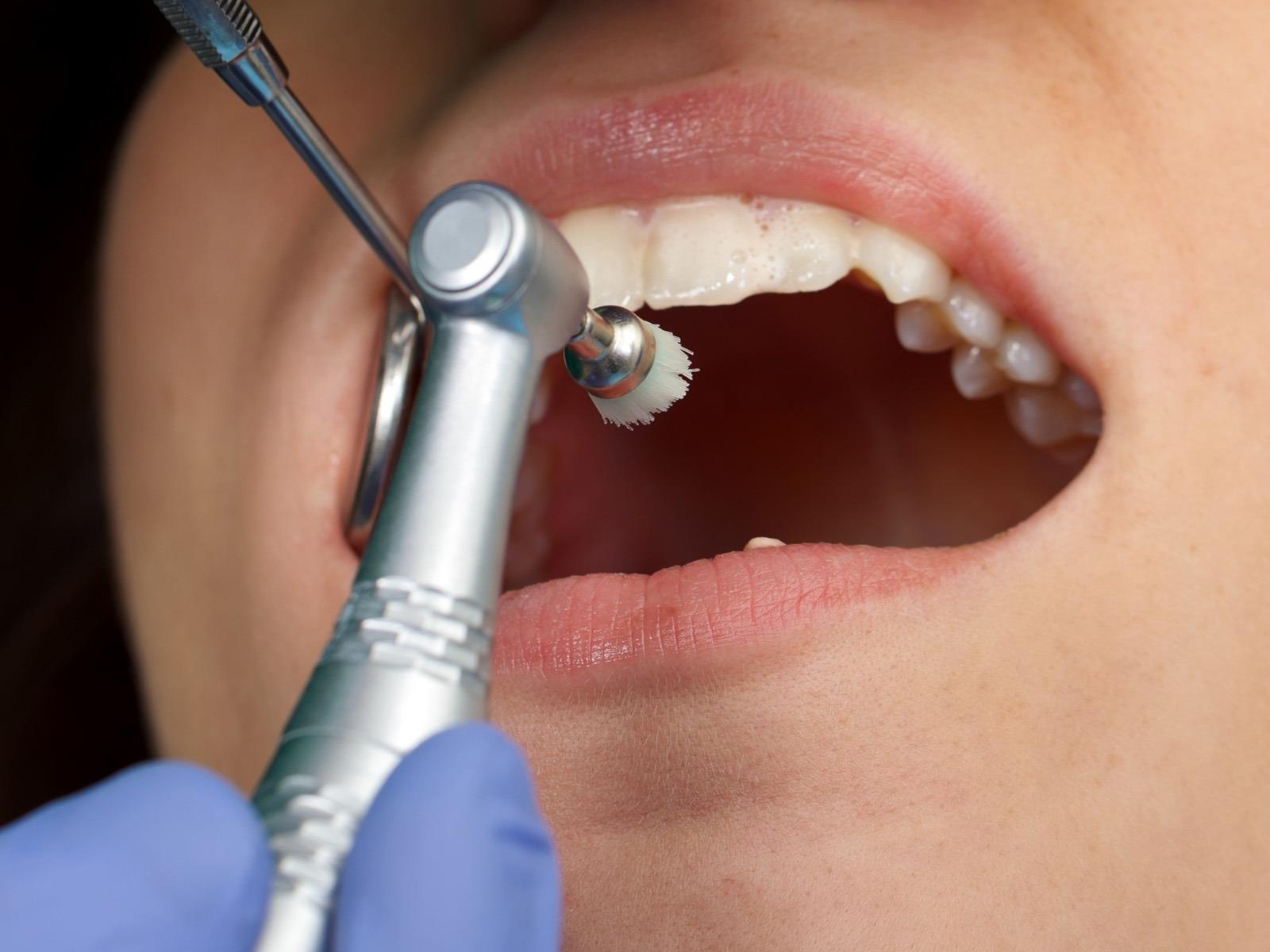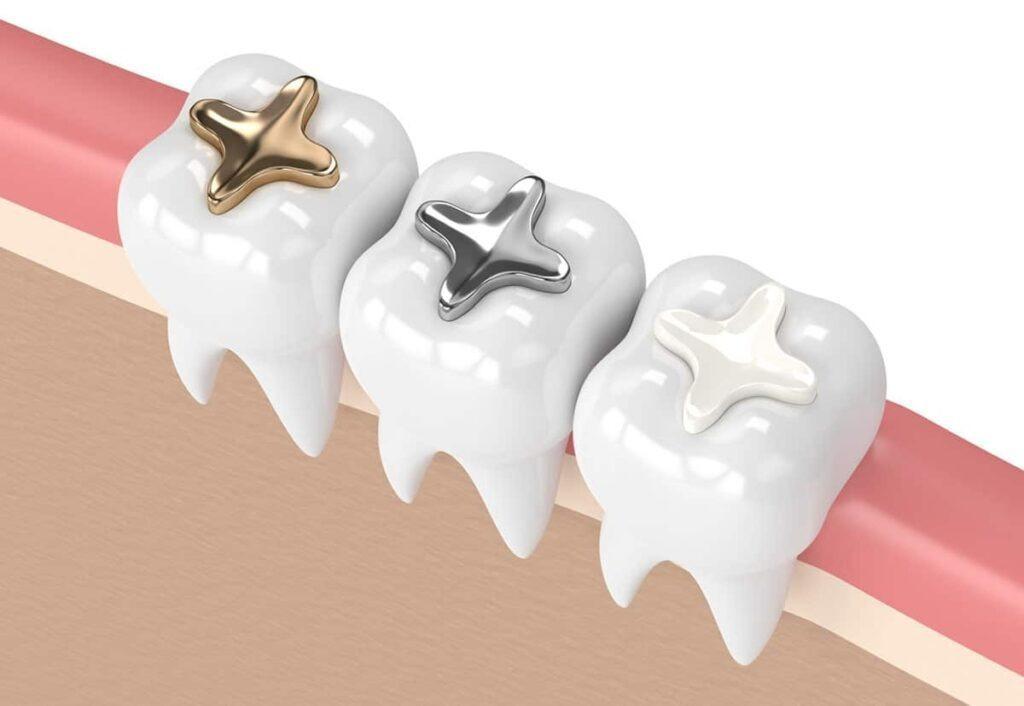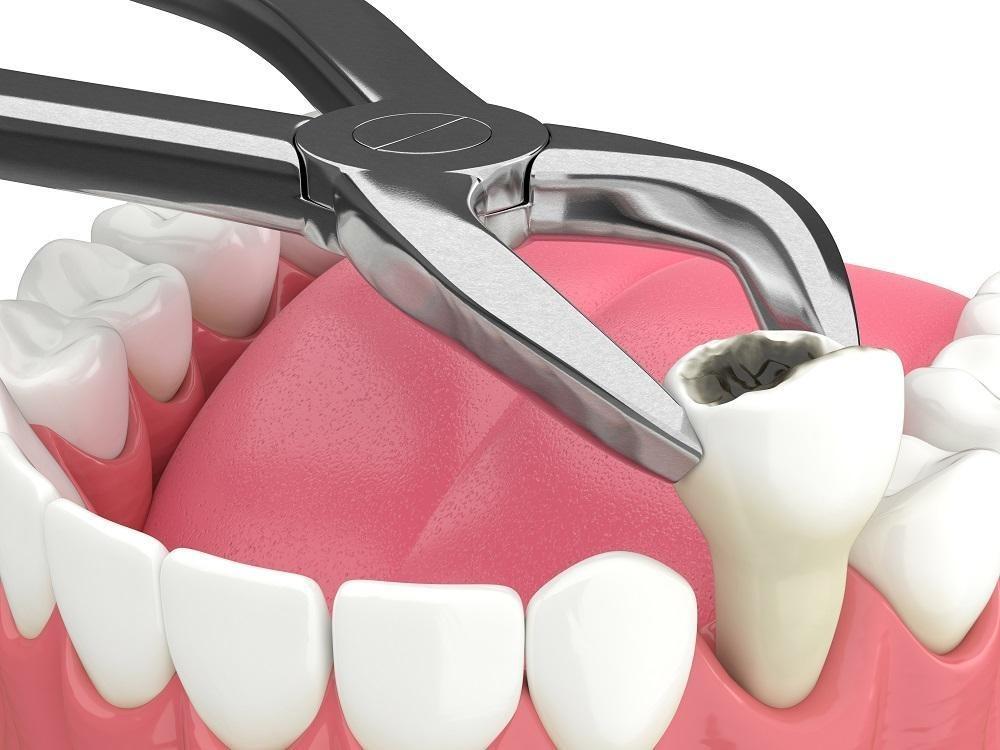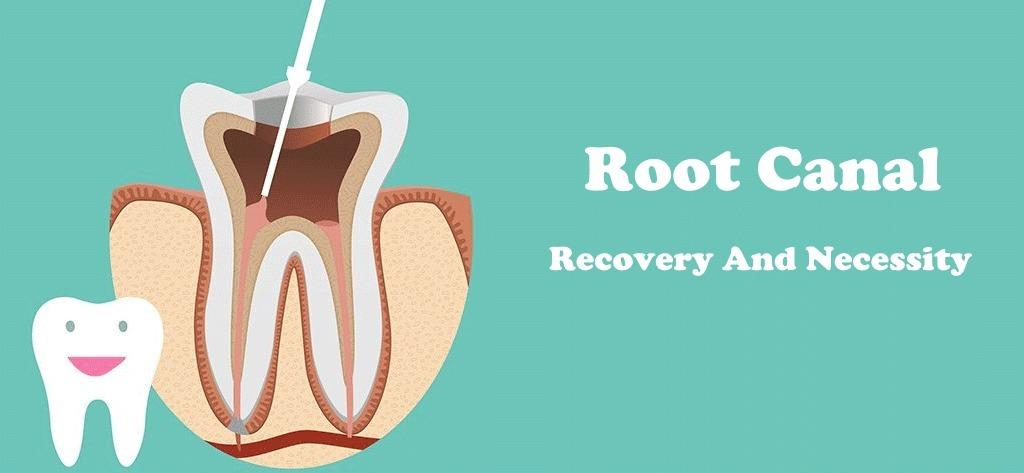Dental cleanings are one of the most important aspects of maintaining good oral health. They help prevent cavities, gum disease, and bad breath while keeping your smile bright and healthy. Many people, however, are confused about the difference between a regular dental cleaning and a deep cleaning. Understanding how they differ is essential because each serves a specific purpose in keeping your teeth and gums healthy.
This article aims to clearly explain what regular dental cleanings and deep cleanings are, how each procedure works, and when they’re necessary. Knowing what to expect from both treatments will help you make informed decisions about your oral care and recognize when your dentist recommends one over the other.
Understanding Dental Cleaning (Prophylaxis)
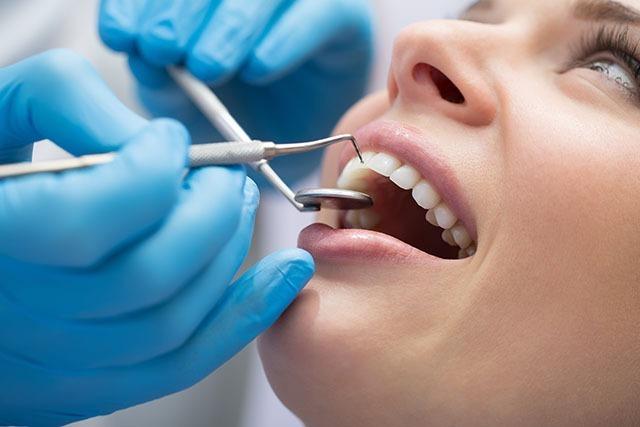
A regular dental cleaning, also called prophylaxis, is a routine preventive procedure performed during standard dental checkups. Its primary purpose is to remove plaque, tartar, and surface stains that brushing and flossing alone can’t eliminate. Regular cleanings focus on cleaning the visible parts of your teeth above the gumline, where bacteria tend to build up over time.
During a regular teeth cleaning, the dentist or hygienist first examines your teeth and gums to check for signs of decay or inflammation. Next, they perform scaling, which removes plaque and tartar using specialized instruments. After scaling, polishing smooths the teeth to prevent bacteria from sticking easily, followed by an optional fluoride treatment to strengthen enamel and reduce cavity risk. Most dental professionals recommend having a cleaning every six months to maintain oral health and prevent gum disease.
Understanding Deep Cleaning (Scaling and Root Planing)
What Is a Deep Cleaning?
A deep cleaning, also known as scaling and root planing, is an advanced dental procedure designed for patients who show signs of gum disease (gingivitis or periodontitis). Unlike a routine cleaning that focuses on the visible surfaces of the teeth, this treatment targets areas below the gumline to remove harmful plaque, tartar, and bacteria that cause infection and inflammation. Deep cleaning helps stop gum disease from progressing and prevents tooth loss by restoring the health of the gum tissues and supporting bone.
This procedure is often recommended when your dentist notices symptoms such as bleeding gums, persistent bad breath, gum recession, or deep pockets between your teeth and gums. By removing the bacteria and toxins responsible for gum inflammation, a deep cleaning promotes healing and strengthens the connection between teeth and gums, leading to improved overall oral health.
How Deep Cleaning Works
The deep cleaning process consists of two major steps: scaling and root planing. During scaling, the dentist or dental hygienist uses specialized instruments (manual or ultrasonic) to remove plaque, tartar, and bacterial buildup from both above and below the gumline. This step eliminates the primary cause of infection, reducing gum inflammation and tenderness.
Next, in the root planing phase, the roots of your teeth are smoothed to make it more difficult for bacteria and plaque to stick in the future. This smoothing process allows the gums to heal and reattach more tightly to the tooth surfaces, minimizing pocket depth and promoting long-term stability. Because this treatment involves sensitive gum tissue, local anesthesia is typically used to keep you comfortable.
Comfort and Recovery
Deep cleaning is usually performed in one or two appointments, depending on the severity of the gum disease and the number of affected areas. After the procedure, you may experience mild tenderness, sensitivity, or slight bleeding, which typically subsides within a few days. Your dentist may prescribe an antibacterial rinse or antibiotics to support healing.
Most patients notice a significant improvement in gum health within weeks. With consistent oral hygiene and regular follow-up visits, deep cleaning can effectively control gum disease and prevent future complications. It’s an essential step in maintaining healthy gums and preserving your natural teeth for years to come.
When Is a Deep Cleaning Needed?
Recognizing the Signs of Gum Disease
A deep cleaning becomes necessary when symptoms of gum disease begin to appear. Common warning signs include bleeding gums, especially during brushing or flossing, persistent bad breath, receding gums, and loose or shifting teeth. You might also notice swelling, redness, or tenderness in your gums. These signs indicate that plaque and tartar have built up beneath the gumline, causing inflammation known as gingivitis, which can progress to periodontitis if left untreated.
As gum disease advances, the supporting bone structure around the teeth starts to weaken, leading to potential tooth loss. At this stage, regular cleanings are no longer enough, and a deep cleaning is required to remove bacteria from the roots and pockets below the gumline. Recognizing these symptoms early can prevent serious dental issues and preserve your natural teeth.
How Dentists Diagnose the Need for Deep Cleaning
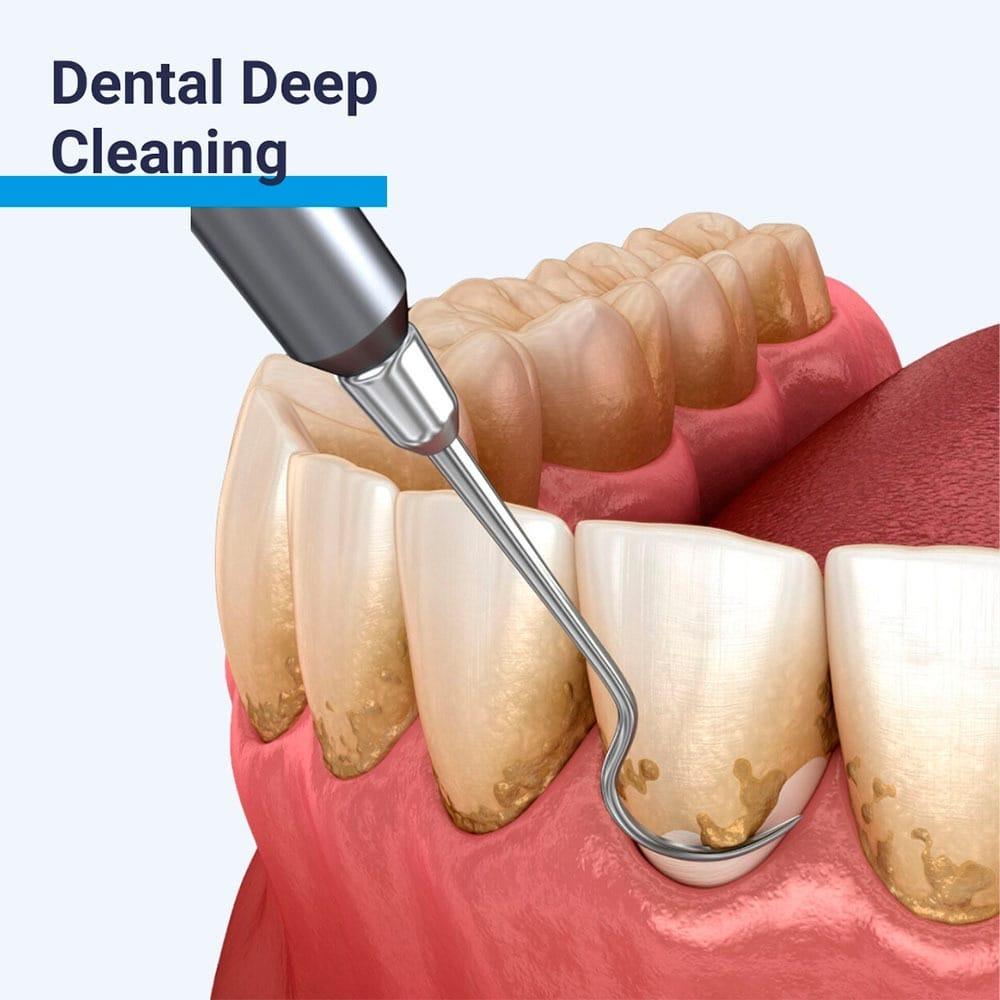
Dentists use a combination of clinical examinations, gum pocket measurements, and dental X-rays to determine whether you need a deep cleaning. During a periodontal assessment, your dentist measures the depth of the spaces (pockets) between your teeth and gums using a special probe. Healthy gums typically have pocket depths of 1–3 millimeters. If pockets measure 4 mm or deeper, it often indicates the presence of gum disease that requires deep cleaning.
X-rays help your dentist assess whether bone loss has occurred beneath the gumline, a clear sign of periodontitis. Based on these findings, your dentist will recommend a treatment plan, which may include scaling and root planing to stop the disease’s progression.
Importance of Early Intervention
Treating gum disease early with deep cleaning can make a significant difference in your oral health. Early intervention not only helps control infection but also prevents further damage to your gums and bone structure. If neglected, gum disease can lead to severe periodontitis, tooth loss, and even systemic health issues such as heart disease and diabetes.
By acting promptly when symptoms appear and following your dentist’s recommendations, you can reverse early gum disease and maintain strong, healthy gums. Regular dental visits and good oral hygiene habits are essential for preventing the need for more invasive treatments in the future.
Key Differences Between Regular Cleaning and Deep Cleaning
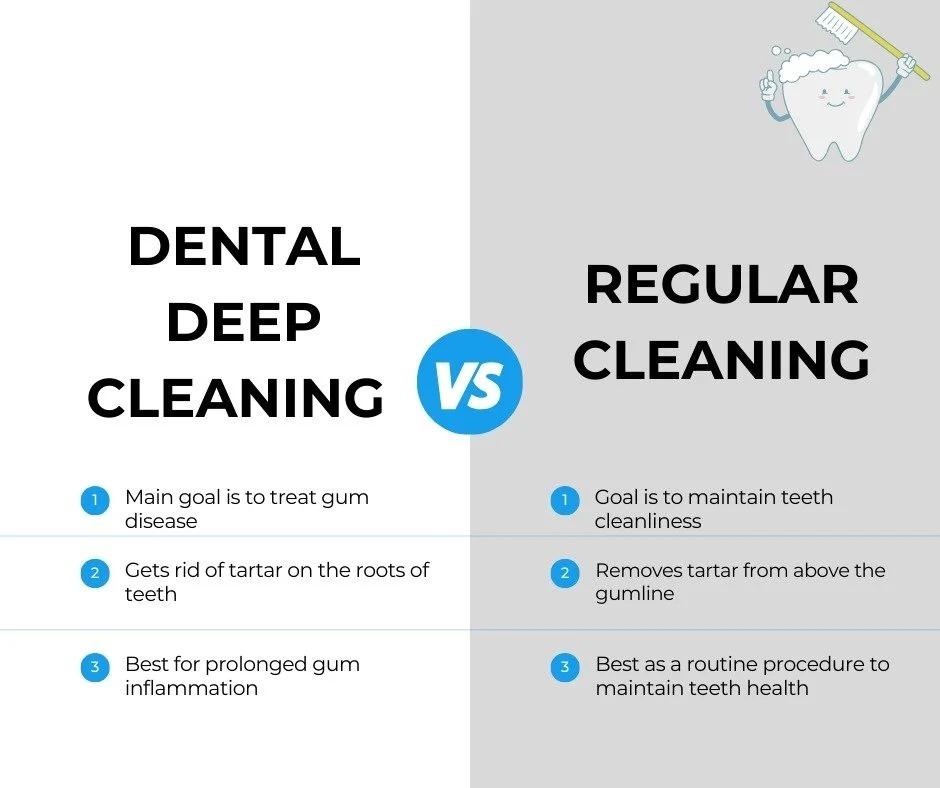
Purpose: Maintenance vs. Treatment of Gum Disease
The primary difference between regular dental cleaning and deep cleaning lies in their purpose. A regular cleaning (prophylaxis) is a preventive measure designed to maintain oral health by removing everyday plaque and tartar buildup above the gumline. It helps keep teeth clean, prevents cavities, and maintains fresh breath.
In contrast, a deep cleaning (scaling and root planing) is a therapeutic procedure performed when gum disease has already developed. Its main goal is to treat infection, reduce inflammation, and stop gum disease from worsening. While a regular cleaning is part of routine oral care, deep cleaning is a corrective treatment necessary to restore gum health and prevent tooth loss.
Depth: Above vs. Below the Gumline
A key distinction between the two lies in how deeply the dentist cleans. Regular cleaning focuses on removing plaque and tartar above the gumline on the visible surfaces of the teeth. It addresses buildup caused by food particles, bacteria, and everyday plaque that brushing and flossing might miss.
Deep cleaning, however, goes below the gumline, targeting the roots of the teeth and the gum pockets where bacteria and plaque accumulate. This is crucial for patients with gum disease because the bacteria hiding beneath the gums can lead to bone loss and tooth mobility if left untreated.
Frequency: Routine vs. As Needed for Treatment
Regular dental cleanings are typically recommended every six months as part of standard preventive care. They’re suitable for people with healthy gums and minimal tartar buildup. Consistent cleanings help prevent gum disease from developing in the first place.
Deep cleanings, on the other hand, are performed as needed, based on your dentist’s diagnosis. After an initial deep cleaning, patients may need follow-up appointments every 3–4 months for maintenance, depending on the severity of gum disease and how well they follow oral hygiene practices at home.
Procedure Length: One Short Visit vs. Multiple Longer Appointments
A regular cleaning usually takes 30–60 minutes and is completed in a single visit. It’s a quick, painless process involving scaling, polishing, and sometimes fluoride application.
In contrast, a deep cleaning can take one to two hours per session and may require multiple appointments, especially if both the upper and lower gums are affected. The use of local anesthesia and the detailed nature of cleaning below the gumline make the process longer and more thorough.
Aftercare: Minimal vs. More Intensive
After a regular cleaning, patients can resume normal activities immediately with minimal discomfort. You might experience slight sensitivity for a few hours, but no special aftercare is needed beyond routine brushing and flossing.
After a deep cleaning, however, the gums may feel tender, swollen, or slightly sore for a few days. Dentists often recommend using saltwater rinses, avoiding hard or spicy foods, and practicing gentle brushing. Follow-up visits help monitor healing and ensure that gum pockets are shrinking as expected.
Aftercare and Recovery
Post-Procedure Care for Both Types of Cleanings
After a regular dental cleaning, recovery is typically immediate, and you can return to normal activities right away. You may experience a slight tingling sensation from the polishing paste or fluoride treatment, but this fades quickly. Brushing and flossing can resume the same day, and drinking water helps rinse away any residual cleaning materials. Maintaining good oral hygiene at home, brushing twice a day, flossing daily, and using mouthwash, helps preserve the freshness and cleanliness of your teeth until your next appointment.
In contrast, after a deep cleaning (scaling and root planing), your gums may need a few days to recover fully. You might notice mild soreness, tenderness, or light bleeding, which is normal as the gum tissues heal. Dentists often recommend using a saltwater rinse or a prescribed antibacterial mouthwash to keep the area clean and reduce inflammation. Avoid eating hard, crunchy, or spicy foods for at least 24–48 hours, as these can irritate sensitive gums.
Managing Sensitivity, Bleeding, or Mild Swelling After Deep Cleaning
Following a deep cleaning, it’s common to experience temporary tooth sensitivity due to exposed root surfaces and gum irritation. Using a sensitive-teeth toothpaste and avoiding very hot or cold foods can help minimize discomfort. If your dentist recommends, you can take over-the-counter pain relievers like ibuprofen to ease soreness and reduce swelling. Applying an ice pack on the outside of your face for short intervals during the first 24 hours can also help manage inflammation.
Light bleeding when brushing or flossing is normal for a few days but should gradually stop as your gums heal. If bleeding or swelling persists beyond a week, it’s important to contact your dentist, as it may indicate infection or delayed healing. Proper care during this recovery phase helps your gums reattach to the teeth more firmly, improving overall oral stability.
Importance of Follow-Up Visits and Good Oral Hygiene Habits
Follow-up appointments are essential after a deep cleaning to ensure that your gums are healing properly and that gum pockets are shrinking. During these visits, your dentist will check for signs of improvement and may perform additional cleanings or maintenance treatments if necessary. Skipping dental checkups can allow bacteria to return, undoing the progress made by the procedure.
Maintaining excellent oral hygiene habits is the key to long-term success after both regular and deep cleanings. Brush at least twice daily with fluoride toothpaste, floss once a day to remove plaque between teeth, and consider using an antimicrobial mouthwash. A balanced diet low in sugar and regular dental visits every six months can help prevent gum disease from recurring and keep your smile healthy and strong.
Benefits of Regular Cleaning
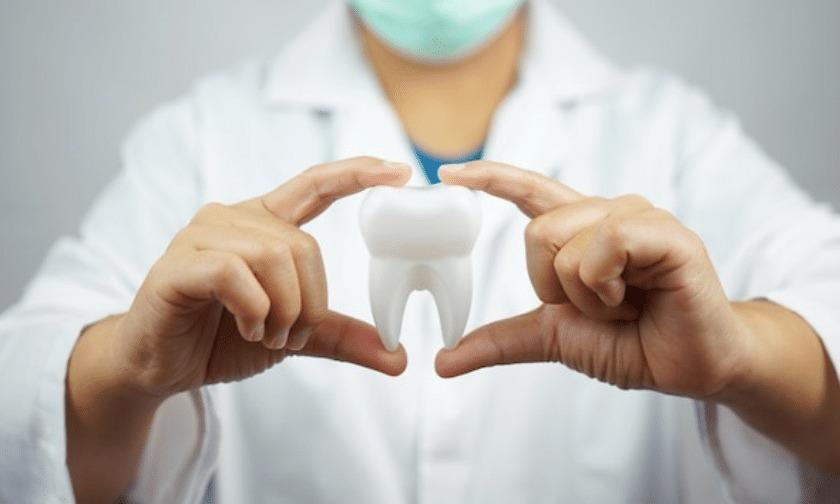
A regular dental cleaning is a cornerstone of preventive oral care. It effectively removes plaque and tartar buildup above the gumline, preventing cavities, gum inflammation, and bad breath. Regular cleanings also help detect early signs of dental issues such as small cavities, gum irritation, or enamel wear before they become serious. Additionally, the polishing step leaves your teeth smooth and shiny, making it harder for bacteria and stains to cling to the surface, helping you maintain a bright, confident smile.
Beyond cosmetic benefits, routine cleanings play a vital role in maintaining overall oral health. By scheduling these appointments every six months, you can prevent gum disease from developing, reduce the risk of tooth decay, and keep your breath fresh. Regular cleanings also contribute to better systemic health, as research has shown links between gum disease and conditions like heart disease and diabetes.
Benefits of Deep Cleaning
A deep cleaning (scaling and root planing) provides therapeutic benefits that go beyond surface cleaning. It’s specifically designed to treat and control gum disease by removing bacteria, plaque, and tartar from below the gumline areas that a toothbrush or floss can’t reach. This process helps stop the progression of gingivitis and periodontitis, reducing gum inflammation and encouraging the gums to heal and reattach to the teeth.
Deep cleaning not only promotes healthier gums but also helps prevent tooth loss by protecting the bone and tissue supporting your teeth. With consistent follow-up care, deep cleaning can reverse early gum disease, restore oral balance, and ensure long-term dental stability. Patients who undergo deep cleaning often notice less bleeding, fresher breath, and a significant improvement in overall gum health.
How Both Support Long-Term Oral Health
Both regular and deep cleanings serve essential but complementary roles in maintaining lifelong oral health. Regular cleanings are preventive, keeping your teeth and gums in top condition and avoiding disease before it starts. Deep cleanings, on the other hand, are corrective, addressing existing gum issues to restore oral health and prevent further complications.
Together, they create a complete dental care plan that supports not just your smile but also your overall well-being. Maintaining consistent dental visits, following good home care habits, and addressing dental concerns early ensures that your mouth stays healthy and your teeth last a lifetime.
Conclusion
Understanding the difference between regular and deep dental cleanings is key to maintaining optimal oral health. Regular cleanings focus on prevention, keeping your mouth clean, fresh, and cavity-free, while deep cleanings are vital for treating gum disease and restoring gum health. Both play an important role in preserving your teeth, gums, and overall wellness.
Scheduling regular dental visits allows your dentist to monitor your oral health, detect early warning signs, and recommend the right type of cleaning based on your specific needs. Whether you need a routine cleaning or a deeper treatment, consistent professional care combined with good daily hygiene will help you maintain a healthy, beautiful smile for life.

